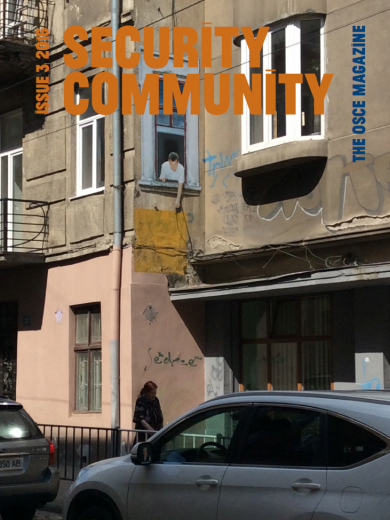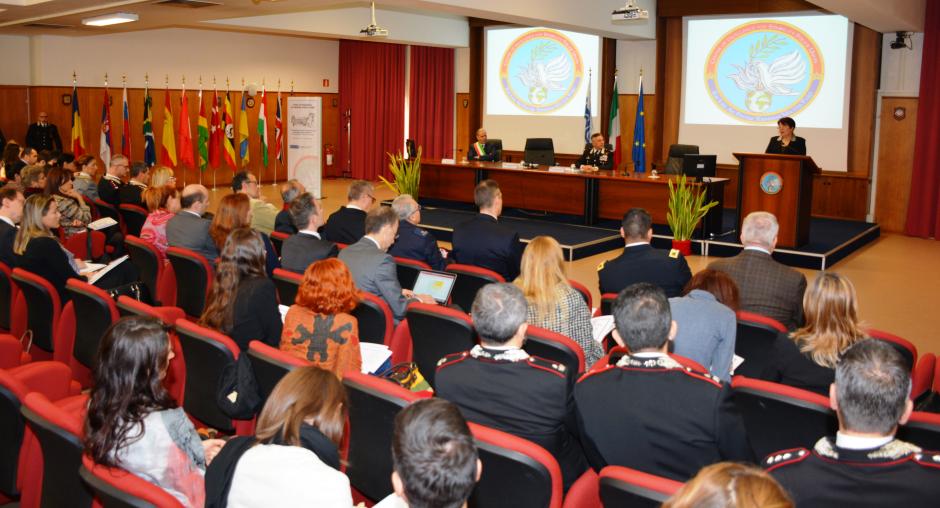An Inextricable Link
By Madina Jarbussynova
In a rapidly globalizing world, tackling human trafficking will only be effective if we understand its connection with mixed migration flows and the ever-changing international political and social context in which they occur. In response to the unprecedented displacement stemming from the prolonged instability along the Mediterranean shores, the Sahel and elsewhere, the Office of the Special Representative and Co-ordinator for Combating Trafficking in Human Beings (OSR/CTHB ) has quickly adjusted its efforts to fight trafficking in human beings towards raising awareness of the perilous links between migration and human exploitation.
In the year 2015, FRONTEX, the European Union’s external border agency, calculated more than 1.8 million detections of illegal entries, associated with an estimated one million individuals – more than 4.5 times the total number of arrivals for 2014, according to the UN High Commissioner for Refugees (UNHCR). To put this figure into perspective, it corresponds to the entire population of Vienna or Hamburg. Preliminary figures from 2016 show similar results. These statistics serve not only to illuminate the scale of the recent migration flow into Europe, but perhaps more importantly, should alert us to the scale of the response that is needed.
Too often in times of crisis, one sees profiteers emerge who seek to exploit the misery and vulnerability of others. Traffickers prey on individuals desperately lacking in security and opportunity, using threats and deception to control them for their own ends. Women and children are particularly at risk of being coerced into complying with the demands of those promising them safe passage to a better life. With the recent tightening of immigration policies, migration routes are now often longer, more expensive and life-threatening. By limiting people’s opportunities for legal migration, this tightening has inadvertently aided both human smugglers and human traffickers.
Human Smuggling vs. Human Trafficking
For many, the terms “human smuggling” and “human trafficking” have become simply interchangeable, resulting in a blurring of the distinction between the two. Yet, as often pointed out by leading international organizations and practitioners in the field, they are separate crimes.
Smuggling always involves the crossing of an international border and individuals who pay a smuggler to gain entry into a state do so voluntarily, at least in principle. Europol estimates that more than 90 per cent of the more than one million irregular migrants who surged into Europe last year used services provided by more than 40,000 people operating in loose criminal networks. With services rendered ranging from forging documents to bribing law enforcement officials, Europol estimates that criminal networks involved in migrant smuggling had a turnover of between €3 billion and €6 billion in 2015.
Human trafficking, by definition, involves some form of coercion, physical or psychological, for the purpose of exploitation of the victim. As laid out in Article 3 of the UN Protocol to Prevent, Suppress and Punish Trafficking in Persons, the exploitation must include “at a minimum, the prostitution of others or other forms of sexual exploitation, forced labour or services, slavery or practices similar to slavery, servitude or the removal of organs”. Human trafficking is thus clearly a gross violation of human rights and dignity. As opposed to smuggling, it can also very well occur within national borders.
Given this clear distinction between human smuggling and human trafficking, why is it increasingly blurred, especially among the media and the general public? Interpol offer a compelling argument: although in principal, the relationship between smuggler and migrant ends once the individual arrives in the new country, there is considerable evidence that smugglers continue to exploit illegal migrants after arrival, through threats and demands for additional fees. Clearly, human trafficking is often a direct consequence of human smuggling among mixed migration flows.
By way of illustration, recent International Organization for Migration (IOM) data predicts that of more than 3,600 Nigerian women arriving by boat in Italy in the first six months of 2016 (double the number registered for 2015), more than 80 per cent will be trafficked into prostitution in Italy and across Europe. It is an increasingly sad reality that many women, after having survived a perilous and often life-threatening journey, simply disappear from asylum and reception centres into the hands of traffickers seeking to exploit them. Salvatore Vella, Deputy Chief Prosecutor in Agrigento, Sicily, recently lamented the fact that many asylum and reception centres were actually acting as “a sort of warehouse where these girls are temporarily stocked…before being picked up by mobsters”.
As regards migrant children, Europol reports that 85,482 unaccompanied minors arrived in Europe in 2015. There is little sign of this abating, with UNHCR noting, for example, that from January to June this year the figure for unaccompanied minors arriving in Italy rose to 10,524, as compared with 4,410 during the same period in 2015. The European Migrant Smuggling Centre estimated in January 2016 that over 10,000 migrant children were unaccounted for. According to Věra Jourová, the European Commissioner for Justice, they run a high risk of being exploited by criminal gangs for human trafficking, sex work or slavery.
In view of such findings, the OSCE is refining its approach to addressing the intertwined phenomena of smuggling and human trafficking. Only when the link between the two is duly recognized, understood and analysed as having a concrete connection, will it be possible for governmental and non-governmental actors to better respond to them.
OSCE Action
Despite the seriousness of these crimes, human trafficking in the context of crisis-driven migration is still largely overlooked by both governmental and non-governmental actors. Given the unique leverage of the OSCE as a regional security organization with human rights as part of its core agenda, my team and I at the OSR/CTHB have striven, since the onset of the migration crisis and the deterioration of the situation in Ukraine, to counter the accompanying exploitation of human life by traffickers. I have travelled to Ukraine several times and worked with the authorities and the Special Monitoring Mission to Ukraine (SMM) to raise their awareness as well as that of displaced persons themselves of the risks the crisis poses.
I have also carried out official visits to temporary protection and first reception centres in key locations along migration routes in the OSCE region, including in Turkey and Italy. Observing the situation on the ground has proven invaluable in assessing the scale of the danger of human trafficking at these sites and confirmed how important it is for migrants themselves to be aware of the perils they face. If victims of trafficking are able to identify themselves as such, they will be able to seek help more quickly and avoid being further abused or coerced.
These visits have enabled me to experience first-hand the progress made by authorities in identifying potential victims among mixed flows of migrants and refugees. It has become clear to me that there is still considerable potential for improving the capacity of frontline operators to screen such flows so as to promptly identify victims of trafficking. This is partly why our Office is further developing our guidelines on national referral mechanisms. Taking a participatory approach, we are beginning with a first consultation with anti-trafficking NGOs from the OSCE region and representatives of UN agencies in Geneva on 23 and 24 November.
Witnessing the current lack of efficient co-operation schemes and diverging legislative frameworks has provided inspiration for an ambitious multi-disciplinary and cross-sectorial project the OSCE is implementing in Vicenza, Italy, in 2016 and 2017. From 14 to 18 November, a first group of around 200 law enforcement officials, prosecutors, labour inspectors, financial investigators and civil society representatives from frontline countries of origin, destination and transit along migration routes met at the Centre of Excellence for Stability Police Units (CoEPSU) in Vicenza. After two days of intense discussion of theoretical, methodological and technical aspects of anti-trafficking action, they participated in a three-day simulation exercise on the grounds of the Centre.
The goal of the exercise was to promote practical co-operation and joint solutions for victim identification and criminal prosecution. It focused on trafficking for sexual and labour exploitation and highlighted the fact that financial investigation is often the best means of dismantling complex criminal organizations. Reality-based scripts acted out by actors assured the realism of the simulations. At the same time, they contained no country-specific references and were therefore suitable for beneficiaries across the whole OSCE region. Experts coached the participants on how best to respond to situations as they unfolded before them.
With one third of the selected trainees for this first simulation exercise coming from the Western Balkans, it is my sincere hope that the skill and knowledge they acquired in Vicenza will be put to good use in the regional context. The exercise is an excellent example of how OSCE-wide projects can complement our support of regional co-operation in South-Eastern Europe, where we are working with our field missions and national partners to promote concerted action in preventing and tackling human trafficking along the Western Balkan route.
In conclusion, this article offers but a cursory insight into the nature of some of the projects which the OSR/CTHB has been undertaking in 2016. Despite the scale and breadth of the challenges our region is facing, I am convinced that thanks to the OSCE’s comprehensive approach to security and our close co-operation with international and local partners, we can make a significant contribution to highlighting and mitigating the scourge of human trafficking. In doing so, each and every one of us has a duty to recognize a human being in every single individual on the move.
Madina Jarbussynova is the OSCE Special Representative and Co-ordinator for Combating Trafficking in Human Beings.
Welcome to Security Community
Security Community is the OSCE’s online space for expert analysis and personal perspectives on security issues.
The views expressed in the articles are those of the authors and do not necessarily reflect the official position of the OSCE and its participating States.


